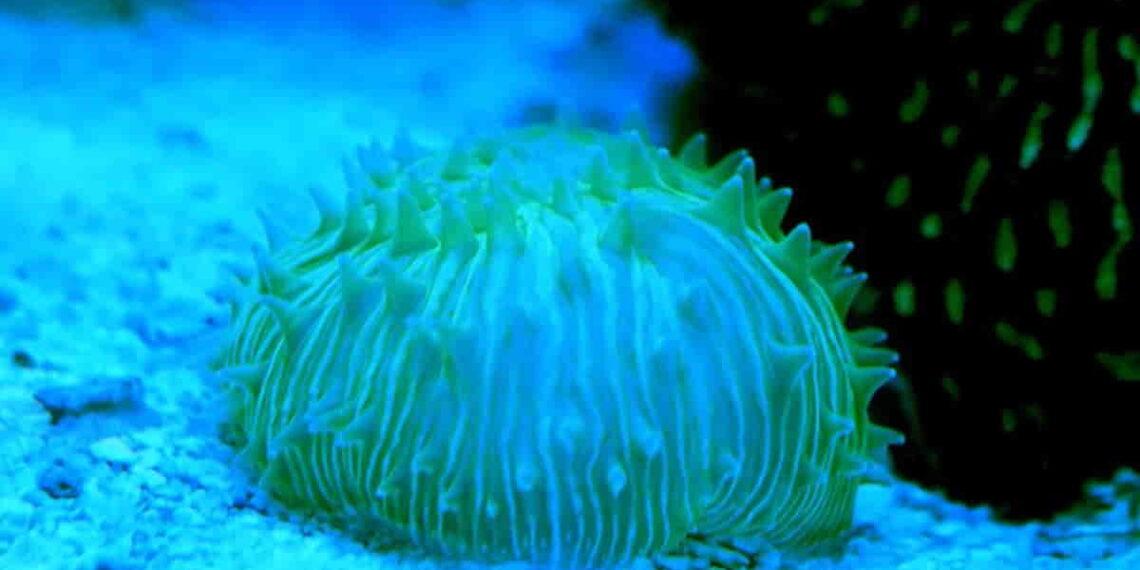“Walking” Coral Moves Toward Blue Light, New Study Reveals Remarkable Behavior
Corals, typically known for being stationary organisms, have just been observed displaying a surprising ability to “walk” toward blue light, similar to the pulsing movement of jellyfish. A new study focused on the free-living mushroom coral Cycloseris cyclolites has shed light on this unexpected behavior, offering new insights into coral movement and survival strategies.
A Shift from Stationary to Active Movement
While most corals are sessile—remaining fixed to a surface throughout their life—the mushroom coral C. cyclolites starts life anchored to a substrate. As it matures, it becomes mobile, dissolving its stem and moving to new locations. This species is typically found in high-energy areas of the Indo-Pacific, where strong waves and competition for space make survival challenging. The ability to migrate toward deeper, calmer waters helps these corals survive by reducing wave energy and competition for food and sunlight.
Dr. Brett Lewis, lead author of the study and postdoctoral research fellow at the Queensland University of Technology, explained that these environmental pressures force C. cyclolites to move and relocate, enhancing their chances of reproduction and survival.
Groundbreaking Discovery of Active Movement
Previous studies hinted that some free-living corals could move in response to light, but how they navigated their environment remained unclear due to limitations in imaging technology. This new research, published in PLOS One on January 22, 2025, reveals that C. cyclolites moves actively by a technique known as pulsed inflation when exposed to blue light. This movement pattern mimics the pulsing, swimming motions of jellyfish, challenging prior assumptions about coral behavior.
The Fascinating Behavior: Toward the Blue Light
To explore this, Lewis and his team collected five C. cyclolites specimens from the coast of Cairns, Australia, and transported them to an aquarium at Queensland University of Technology. There, they tested the corals’ response to blue and white light.
The results were striking: C. cyclolites showed a strong preference for blue light, with most corals moving toward it in a clear phototactic response. The corals exhibited periodic bursts of movement, or pulsed inflation, that lasted for one to two hours. In blue light trials, some corals moved as far as 220 millimeters (8.7 inches) within 24 hours, despite being limited by the tank walls.
In contrast, only 13.3% of the corals moved in response to white light, traveling significantly shorter distances. When both blue and white light were presented together, all corals moved toward the blue light, completely avoiding the white light.
Understanding the Mechanism: Pulsed Inflation
The movement was driven by a combination of three factors: tissue inflation, the expansion of pads on the coral’s underside, and the twisting and contracting of the outer tissues. These mechanisms work together to create the pulsed inflation movement, allowing the coral to “walk” across surfaces.
While this is similar to how jellyfish move through water using pulsed inflation, C. cyclolites uses this technique to traverse surfaces, not swim through water. This unique movement suggests that corals may share similar complex biomechanics and possibly a comparable nervous system to jellyfish, their evolutionary relatives.
Why It Matters: Implications for Conservation and Ecology
The study’s findings could have far-reaching implications for coral conservation and understanding coral ecology. According to marine biologist Andrew Davies, who was not involved in the study, understanding how species like C. cyclolites respond to light could shed light on their development and behavior, including the role of light in spawning and the behavior of coral larvae.
For coral restoration and conservation efforts, this research highlights the importance of understanding coral movement and how light influences coral behavior. If other corals exhibit similar light-responsive behaviors, it could inform strategies for restoring coral habitats and ensuring more successful outcomes in conservation programs.
Conclusion
The discovery that Cycloseris cyclolites actively “walks” toward blue light not only surprises us but also opens a window into the complexities of coral life. This study challenges the long-standing assumption that corals are purely passive organisms, revealing that some species have sophisticated, light-driven behaviors that may be crucial for their survival and reproduction. The knowledge gained could guide future conservation efforts, offering hope for the preservation of these vital marine ecosystems.
This article was rewritten by JournosNews.com based on verified reporting from trusted sources. The content has been independently reviewed, fact-checked, and edited for accuracy, neutrality, tone, and global readability in accordance with Google News and AdSense standards.
All opinions, quotes, or statements from contributors, experts, or sourced organizations do not necessarily reflect the views of JournosNews.com. JournosNews.com maintains full editorial independence from any external funders, sponsors, or organizations.
Stay informed with JournosNews.com — your trusted source for verified global reporting and in-depth analysis. Follow us on Google News, BlueSky, and X for real-time updates.














